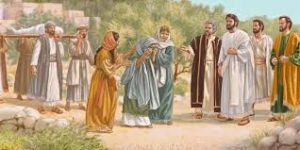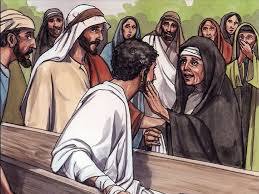Jesus Raises a Widow’s Son
Luke 7: 11-17
Jesus raises a widow’s son DIG: In Second Kings 4:8-37 it tells us that Shunem and Nain are very close to each other. In light of that, why did Christ perform this miracle in this particular town? What was the significance of this woman being a widow? Of this being her only son? What did He reveal about Himself? What drew Jesus to this funeral procession?
REFLECT: What does this story, and that of the faith of the centurion in the previous file, tell us about Jesus? How does His love and authority make a difference for you? When will you hear His voice? When was the last time you experienced the Lord’s compassion? When has the Yeshua ha-Meshiach restored something for you that you never thought you could get back?
The early spring in Galilee was surely the truest realization of the picture in the Song of Solomon, when the earth dressed herself beautifully and the air sang songs of new life. It seemed as if each day brought a widening circle of power on the part of the Lord; as if each day also brought fresh surprise and new gladness. The day before it was the sorrow of the Gentile centurion that stirred the heart of the Supreme Commander of life and death. Today it is the same sorrow of a Jewish mother, which touched the heart of the Son of Miryam. In that Presence, grief and death could not continue. It didn’t matter if He had to go into a Gentile’s house or had to touch a dead body – neither could defile Him.
Soon afterward healing the centurion’s servant, Jesus left Capernaum and went to a town called Nain (Luke 7:11a). It was about twenty-five miles, but, even walking the whole way there would be no difficulty in reaching Nain by afternoon when funerals often took place. Various roads lead to, and from Nain; that which stretches to the Sea of Galilee and up to Capernaum is clearly marked.

And at that time, Messiah’s apostles and a large crowd went along with Him. But, as He approached the town gate, a dead person was being carried out – the only son of his mother, and she was a widow. And a large crowd from the town was with her also (Luke 7:11b-12). As the two processions approached each other on the narrow road, the question was who would give way to the other? We know what ancient Jewish custom would have demanded. For, of all the sacred duties, none was more strictly enforced than that of comforting the mourners and showing respect to the dead by accompanying the procession to the burial. The popular idea that the spirit of the dead hovered near the unburied remains for three days, must have given intensity to such feelings.
We can only imagine the scene, the watchful anxiety, and the deepening care, the passionate longing of a mother to retain her one treasure. The loss of an only son was especially bitter. After she lost her husband, then her son would support her (under the Torah), but, when her son died she had lost her livelihood and would be reduced to living the rest of her life as a beggar. After the burial, there would be the gradual fading out of the light, the farewell, and then the terrible burst of sorrow.
And now all that was left for the mother to do was to sit on the ground and moan. Before the funeral she would not eat meat, nor drink wine. What little she ate in the house of a neighbor, or in another room, she ate it with her back to her dead son. Devout friends would help her with the funeral arrangements. Since it was deemed a duty for the poorest Jew to provide at least two shofars and one mourning woman, we can be sure that the widowed mother would not have neglected what was considered the last token of affection.
The day that she had dreaded had come. She was in so much pain she didn’t know if she could continue. The well-known blast of the horn had carried its news that once more the angel of Death had carried out his terrible job. The mournful procession started from the desolate home. Once outside, the funeral orator preceded the bier, proclaiming the good deeds of the dead. Immediately before the dead came the women, this being peculiar to Galilee, the Midrash giving the reason that woman had introduced death to the world. Commonly, the face of the dead body was uncovered. As the coffin proceeded, barefoot pallbearers would, at frequent intervals, relieve each other so that as many as possible might share in the work of love. During those pauses, there was loud weeping. Behind the bier walked the relatives, his friends, and then a large crowd from the town. The last sad words had been given to the dead. The body had been laid on the ground; hair and nails had been cut, the body washed, anointed, and wrapped in the best the widow could afford.
Then, along the road from Capernaum streamed a large crowd following the Lord of Life. There they met: Life and death. But, the mourners didn’t cause Him to stop. Nor did the large crowd. It was the mother – the look on her face and the redness in her eyes. Messiah knew immediately what was happening. It was her son who was being carried out, her only son. And if anyone knows the pain that comes from losing your son, your only son, God does.
Therefore, the One who was the Man of sorrows and Himself acquainted with grief (Isaiah 53:3) was filled with compassion. His heart went out to her. The verb heart went out translates esplanchnisthe, a verb used numerous times in the gospels to mean loving concern or sympathy. It is related to the noun splanchna, meaning the inner parts of the body. The noun is used ten times in the B’rit Chadashah (Luke 1:78; Second Corinthians 6:12, 7:15; Philippians 1:8, 2:1; Colossians 3:12; Philemon 7, 12 and 20; First John 3:17). She didn’t notice Him because she was still weeping, but He came along side of her and said: Don’t cry (Luke 7:13).617
Then Jesus went up and touched the coffin they were carrying him on, and the bearers stood still. They couldn’t imagine what would happen next. But, the awe of the coming miracle – as it were, the shadow of the opening gates of life, had fallen on them. The miracle-working Rabbi said: Young man, I say to you, get up (Lk 7:14)! He removed his mother’s grief, not by a word of consolation, but, by demonstrating that He was indeed the resurrection and the life (Yn 11:25). Jesus is the Red Heifer, without fault or defect, who delivers us from death through the water of purification (see the commentary on Numbers Df – The Red Heifer).
The Giver of Life also spoke directly to the brother of Mary and Martha lying in the tomb when He said: Lazarus, come out (John 11:43)! We will hear His voice at the Rapture (see my commentary on Revelation, to see link click By –The Rapture of the Church). Scripture tells us: For the Lord Himself will come down from heaven with a rousing cry, with a call from one of the ruling angels, and with God’s shofar; those who died united with the Messiah will be the first to rise; then we who are the left still alive will be caught up with them in the clouds to meet the Lord in the air; and thus we will always be with the Lord (First Thessalonians 4:16-17). He is coming for us with a shout.

Instantly, the dead man sat up and began to talk – solid proof that he was truly alive.It must have seemed to him, as if he woke from a long sleep. Where was he now? Why was his mother crying? Who were those around him? And who was He, whose light and life seemed to fall upon him? Jesus was still the link between the mother and the son, who once again found each other. And so, in the truest sense, Jesus gave him back to his mother (Luke 7:15). Is there any doubt that from that point on, that the mother, the son and the people of Nain trusted in Yeshua as the true Messiah?618
The response to this miracle was immediate. The large crowd from the town was filled with awe, literally fear took possession of all, and praised God. This was not terror but holy reverence. “A great prophet has appeared among us” they said, no doubt thinking of the ministries of Elijah (First Kings 17:17-24) and Elisha (2 Kings Chapters 1 thru 4). “ADONAI has come to help His people,” is common expression in the TaNaKh describing God’s actions on behalf of His people (Exodus 4:31; Ruth 1:6). This news about Jesus spread throughout Judea and the surrounding country (Luke 7:16-17).
What would have drawn Christ to a funeral procession for an only son of a widow? Was it curiosity? Was He attracted by the commotion and crying, the ritual mourning that was part of Middle Eastern funerals? No. Above all else, He was drawn to this scene because of the compassion that always attracts Him to the sorrowful and the needy.
When the Rabbi from Galilee came upon a Jewish leper, He reached out His hand and healed the man because He was filled with compassion (Mark 1:41). When Yeshua sent out the twelve Apostles, He saw the crowds and He had compassion on them because they were harassed and helpless, like sheep without a shepherd (Matthew 9:36). When the miracle-working Rabbi fed the 5,000, He saw a large crowd following after Him, and had compassion on them, because they were like sheep without a shepherd (Mark 6:34). When the Chief Shepherd was passing by Bartimaeus and his friend, they cried out relentlessly for His attention: Jesus, Son of David, have mercy on us! We want to see. Jesus had compassion on them and touched their eyes, saying: Receive your sight. Go, your faith has healed you (Luke 18:35-43). Similarly, in this scene, it was Messiah’s compassion for the widow that drew Him to her side.
We too were once spiritually dead with no hope. But, the Prince of Life had compassion on us and, through His death and resurrection, He raised us from eternal death to eternal life in Him (to see link click Ms – The Eternal Security of the Believer). Just as the people of Nain praised God when they witnessed a wonderful miracle in their midst, so we can rejoice and praise ADONAI for the great work He is doing in our lives. In His mercy, God chose to rescue us and draw us to Himself, revealing His love to us so that we could embrace His salvation: We love because He first loved us (First John 4:19).
Take some time in prayer today and write down the different ways you have experienced the Lord’s compassion and tenderness. Think about the way He rescued you from death through His cross and gave you new life in the Ruach. Try to recall specific situations when you knew His comfort, wisdom, or strength. Look at different members of your family and consider how God has cared for them. As recipients of such love and grace, we are now called to share that love with those around us. Let us ask the Spirit to teach us to love as Jesus loves so that we can become ambassadors of Christ in this world.
Lord, may Your compassion for us fill us with compassion for others, especially those in our families and those who have no personal knowledge of Your great love and mercy.619



Leave A Comment